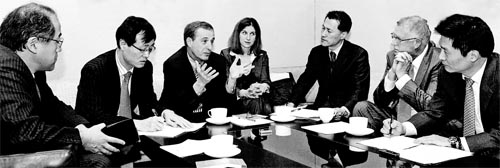The vital shift to services

Participants at an international forum talk about ways to boost Korea’s service industry at the JoongAng Ilbo. By Kim Do-hoon
In recent years, the government has taken the first steps to developing a stronger service sector, but more concerted actions and more popular support are needed. Other economies around the world - both mature and developing - face or faced this same challenge as manufacturing jobs are erased by automation, new technologies and more efficient use of labor. In Korea, however, both the problem and the opportunities are particularly acute. Its economy is more reliant on manufacturing than any other country in the Organisation for Economic Cooperation and Development (OECD), partially because the government’s sustained focus on manufacturing siphoned capital, talent and other resources away from the domestic service industries. As a result, the service sector today has ample room to grow. Korea’s highly educated, hard-working, service-oriented and tech-savvy workforce gives the nation a big advantage in launching a services revolution. The benefits of such a transformation would be measured not just by the creation of national wealth, but also by improvement in the quality of life for Koreans.

Services, meanwhile, have become the primary generators of GDP and employment growth in the world’s advanced economies. Yet Korea’s service sector growth has lagged in relative terms. Services account for 58 percent of the economy in Korea, compared with 80 percent in the United States, 79 percent in the United Kingdom, 73 percent in Japan, and 72 percent in Germany.
Service creates more high-skilled work than manufacturing. Finally, a stronger services sector in Korea would reduce the economy’s exposure to external demand shocks as seen at the end of 2008. And it would reduce Korea’s vulnerability to competition from low-cost manufacturing rivals in countries such as China.
But the service sector challenge is not just about employment. Korea also needs to improve the productivity - the output per labor hour - of its service sector. The McKinsey Global Institute has estimated that for Korea to reach Japan’s current GDP per capita of $37,000 by 2020, GDP would have to grow by around 5.6 percent per year. While this is in line with Korea’s average growth rate since 1990, this pace will be harder to achieve going forward. This is because economic growth is driven by growth in the population and workforce and by growth in productivity. With an aging population and low birthrate, Korea will likely have slower growth in its workforce in the years ahead. So to sustain the historic pace of GDP growth, labor productivity growth will need to be 26 percent higher over the next two decades than it was over the past two.
To achieve this, Korea will need strong contributions from three sources - a vibrant and dynamic private-services sector, an efficient government services sector and a strong manufacturing sector. Sheer size assures that private and public services are the most important potential drivers of overall productivity and GDP growth. Services, including those provided by the government, account for 58 percent of the economy, while manufacturing accounts for just 30 percent, with the rest coming from construction and agriculture.
Therefore, any increase in productivity in services will have nearly double the impact on Korea’s economy than will a similar change in manufacturing.
Korea’s service sector isn’t keeping up its side of the bargain, at least as measured by productivity. According to the OECD, Korea’s private-sector services productivity is only 56 percent of manufacturing productivity, in stark contrast to other developed nations where the two are about the same. This represents a huge opportunity to boost the country’s overall productivity.
This productivity problem is one of the chief legacies of the historic push to build the manufacturing sector. Many of the policies aimed at supporting export-led growth left services starved of capital and innovation resources, often leading to subscale and inefficient operations. In the past, for example, Korean banks were prohibited from lending to consumer- service subsectors such as leisure and real estate. Heavy regulations created significant barriers to entry over the years, and continue to exist for nearly 30 percent of services subsectors. For example, service providers still have to pay charges for site development, while manufacturers do not.
Barriers to foreign competition continue to shelter inefficient service providers, while limits on foreign direct investment (FDI) inhibit the transfer of world-class capabilities. As a result of these types of problems, Korea’s overall service-industry efficiency ranks a dismal 17th out of 18 OECD countries analyzed.
Korea’s lack of competitiveness in services also results from the preponderance of small and medium-sized providers in the sector. This partly reflects policies aimed at protecting them from competition. The government provides small to medium-sized enterprises with subsidies, financial assistance and tax incentives that effectively preserve the status quo. Korea’s nearly 3 million SMEs account for nearly 80 percent of Korea’s service-sector output and nearly 90 percent of its employment.
*Richard Dobbs is a director of the McKinsey Global Institute and is based in Seoul; Roland Villinger is managing director for McKinsey’s Seoul office
From ‘Korea 2020’
28 essays on Korea’s future by McKinsey & Company, Inc.
Random House Korea, Inc.
A project with the International Advisory Council to the Korean President
*Korea must break the mind-set that equates manufacturing with job growth.










with the Korea JoongAng Daily
To write comments, please log in to one of the accounts.
Standards Board Policy (0/250자)